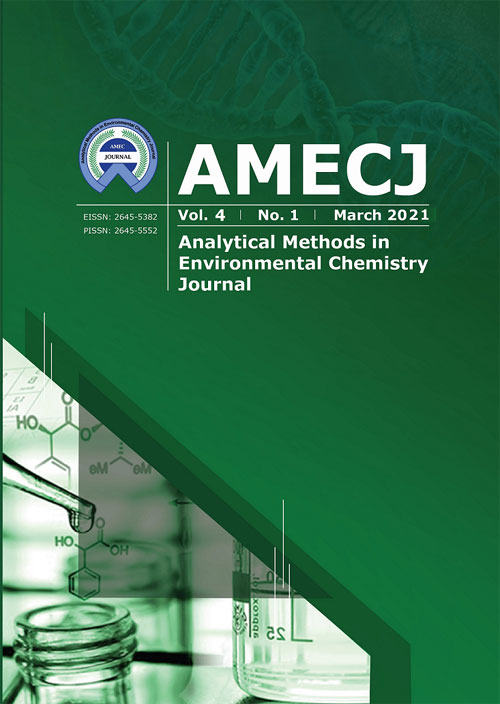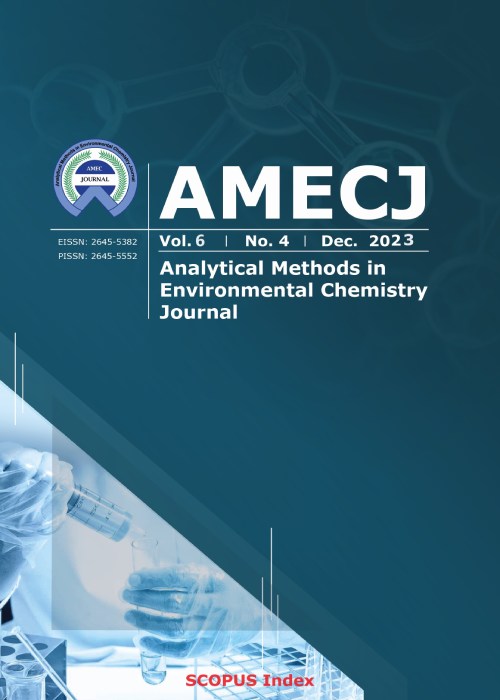فهرست مطالب

Analytical Methods in Environmental Chemistry Journal
Volume:4 Issue: 1, Mar 2021
- تاریخ انتشار: 1400/01/28
- تعداد عناوین: 7
-
Pages 5-15
A simple and fast separation of cadmium (Cd) based on functionalized carbon nanotubes with 2,3-dimercapto-1-propanol (CNTs@DHSP) was achieved in water samples before a determination by atom trap flame atomic absorption spectrometry (AT-FAAS). In this study, Cd(II) ions were extracted by syringe filter membrane-micro solid phase extraction procedure(SFM-μ-SPE). Firstly, 20 mg of the CNTs@DHSP as solid-phase added to 20 mL of water sample in a syringe, then dispersed for 3 min after adjusting pH up to 7 and pass through SFM very slowly. After extraction, the Cd(II) ions were back-extracted from SFM/CNTs@DHSP by 1.0 mL of eluent in acidic pH. Finally, the cadmium concentration was measured by AT-FAAS. Under the optimal conditions, the linear range (2–90 µg L−1), LOD (0.75 µg L−1) and enrichment factor (19.6) were obtained (RSD<1.5%). The adsorption capacity of Cd(II) with the CNTs@DHSP was obtained about 152.6 mg g-1. The method was validated by certified reference materials (SRM, NIST) and ET-AAS in water samples.
Keywords: Cadmium, separation, Water, Functionalized carbon nanotubes, Syringe filter membrane micro solid phase extraction, Atom trap flame atomic absorption -
Pages 16-25
Zinc oxide (ZnO) nanoparticles with an average size of 60 nm have been successfully prepared by microwave irradiation. Carbon paste electrode (CPE) was modified with ZnO nanoparticles and used for the electrochemical oxidation of chlorpheniramine maleate (CPM). Cyclic voltammetry (CV) study of the modified electrode indicated that the oxidation potential shifted towards a lower potential by approximately 106 mV and the peak current was enhanced by 2 fold in comparison to the bare CPE (ZnO/CPE-CV). The electrochemical behaviour was further described by characterization studies of scan rate, pH and concentration of CPM. Under the optimal conditions, the peak current was proportional to CPM concentration in the range of 8.0 ×10-7 to 1.0 × 10-3 mol L-1 with a detection limit of 5.0 × 10-7 mol L-1 by differential pulse voltammetry (DPV). The peak current of CPM is linear in the concentration range of 0.8 - 1000 µM (R2=0.998). The ZnO/CPE has good reproducibility and high stability for the determination of CPM using this electrode. The proposed method was successfully applied to the determination of CPM in pharmaceutical samples. In addition, the important analytical parameters were compared with other methods which show that ZnO/CPE-CV procedure is comparable to recently reported methods.
Keywords: Chlorpheniramine maleate, Pharmaceutical determination, Carbon paste electrode, Cyclic voltammetry, ZnO nanoparticles -
Pages 26-35
Microbial fuel cells (MFCs) are a green and efficient approach to treat wastewater and generate energy. According to the present research, a novel MFC fabricate based on graphite rod electrodes (GRE). The surface of this cathode was modified with iron-functionalized ZSM-5 nanozeolite. The characterization of Iron doping in nanozeolite structure and electrode surface modification were obtained by XRD and EDX analyzes, respectively. Chemical analysis of square wave (Sqw) and cyclic voltammetry (CV) determined for all of three graphite electrodes (G, G-Z and G-Z/Fe) with higher efficiency. Morover, the comparison of experimental results from 72-hour fuel cell steering was evaluated and showed that the G-Z/Fe graphite electrodes has maximum efficiency and effectiveness. Thus, the efficiency of fuel cell output current and residual chemical oxygen demand removal with this electrode increased up to 21.8% and 36.9%, respectively. The effiucient recovery for the modification of the graphite electrode was achieved due to increasing of the specific surface area, the active sites of functionalized nanozeolite and the elevation in the electrical conductivity through the presence of iron particles doped in the ZSM-5/Fe nanocatalyst structure. Therefore, the G-Z/Fe cathode can be used as a favorite electrode for the construction of MFCs based on GRE .
Keywords: Microbial Fuel Cells, Graphite electrodes, Iron-functionalized ZSM-5 nanozeolit, wastewater treatment -
Pages 36-45
In recent decades, large amount of pollutants enter to the environment due to development of technology. Therefore it is necessary to use ecofriendly sorbent to eliminate pollutants. In this research, an dried activated sludge (DAS) was used to decrease Se(IV) pollutant and the effect of operating parameters such as solution pH, the amount of biosorbent, contact time, temperature and initial concentration of selenium were studied. Kinetic data was adjusted to the Langmuir and Freundlich kinetic equations. It was resulted that the Freundlich equation with a correlation coefficient of 0.9956 has the Best match to tetravalent selenium biosorption on DAS. The FT-IR results showed that the biosorption mechanism of selenium tetravalent metal ion on DAS is because of the existence of functional groups on the DAS surface can interact with Se(IV) ions. This study aims to investigate the biosorption capacity of the DAS for tetravalent selenium ions in aqueous solutions.
Keywords: Selenium, Water, wastewater, Speciation, Activated sludge, Biosorption, Isotherms -
Simultaneous adsorption of cationic and anionic dyes using a novel multifunctional mesoporous silicaPages 46-57
In the present work a multifunctional nanoadsorbent was synthesized via a well-designed stepwise route, led to the grafting of an amine group on the interior and acidic sites on the exterior of bimodal mesoporous silica nanoparticles (UVM-7). First, amine and thiol groups were grafted on the interior and exterior pores of silica through co-condensation and post synthesis treatment, respectively. Then, the oxidation of thiol on UVM-7 caused to create sulfonic acid and the subsequent template extraction was carried out to obtain the NH2/UVM-7/SO3H. The results of XRD, the nitrogen sorption, SEM, TEM, FT-IR and elemental analysis revealed the presence of both types of functional groups on UVM-7. Then, simultaneous adsorption of anionic and cationic dyes (Methylene Blue [MB] and Direct Red 23 [Dr]) using NH2/UVM-7/SO3H was investigated. UV-Vis spectrophotometry was utilized for the determination of dyes in single and binary solutions. Langmuir and Freundlich models were used for the fitting of obtained experimental adsorption data and the constants of both isotherms were calculated for MB and Dr. Morover, the calculation of thermodynamic parameters revealed that the adsorption of MB and Dr on NH2/UVM-7/SO3H was endothermic and spontaneous.
Keywords: Amir Vahid, Majid Abdouss, Shahnaz Nayeri, Aliakbar Miran Beigi -
Pages 58-67
A simple and rapid microwave-assisted combustion method was developed to synthesize homogenous carbon nanostructures (HCNS). This research presents a new and novel nanocomposite structures for removal of methylene red (2-(4- Dimethylaminophenylazo)benzoic acid), methylene orange (4-[4-(Dimethylamino)phenylazo]benzenesulfonic acid sodium salt) and methylene blue (3,7-bis(Dimethylamino)phenazathionium chloride)with semi degradation-adsorption solid phase extraction (SDA-SPE) procedure before determination by UV-VIS spectroscopy. A covalent organic frameworks (COFs) with high purity were synthesized and characterized by X-ray diffraction (XRD) and scanning electron microscopy (SEM). The results indicated that the self-assembled carbon nanostructures (COFs) synthesized with the cost-effective method which was used as a novel adsorbent for adsorption of dyes after semi-degradation of methylene red, orange and blue (1-5 mg L-1) as an organic dye by titanium dioxide (TiO2) nanoparticales in presence of UV radiation. Based on results, the COFs/TiO2 has good agreement with the Langmuir adsorption isotherm model with favorite coefficient of determination (R2= 0.9989). The recovery of dye removal based on semi-degradation/adsorption of COFs/TiO2 and adsorption of COFs were obtained 98.7% and 48.3%, respectively (RSD less than 5%). The method was validated by spiking dye to real samples.
Keywords: Carbon nanostructures, Carbon organic frameworks, Dye removal, Semi degradation-adsorption solid phase extraction, Titanium dioxide, UV radiation -
Pages 68-78
In this study, the mixture of nano activated carbon (NAC) and ionic liquid (3-triphenylphosphonio-propane-1-sulfonate; C21H21O3PS) was coated on fused silica fiber of SPME holder (NAC-IL-FSF/SPME). Then NAC/IL was used for determining of benzene in soil and vegetables samples (1.0 g, n=50) surrounding a chemical industry zone. After benzene adsorption on NAC-IL based on head space solid phase micoextraction (HS-SPME), the concentration of benzene was simply determined by introducing probe to injector of gas chromatography with flame-ionization detection (GC-FID). All effected parameters such as the sorbent mass, the amount of sample, the temperature, and the interaction time were optimized in glass chromatography vials by static procedures. The benzene vapor was absorbed from soil and vegetables samples with NAC-IL-FSF/SPME holder for 10 min at 80oC (10 mg of NAC and 0.1 g of ionic liquid in 0.5 mL of acetone coated on FSF). Then the benzene was desorbed and determined by GC-FID spectrometry. The extraction efficiency and absorption capacity of adsorbent were obtained 98.5% and 127.2 mg g-1, respectively. The high surface area of NAC and favorite interaction of aromatic chain in IL (π-π), caused to efficiently remove of benzene vapor by HS-SPME procedure as compared to other nanostructures.
Keywords: Benzene, Soil, vegetables, Nano activated carbon, Ionic liquid, Headspace solid phase micoextraction, Gas chromatography spectrometry


